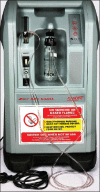The anaesthesia gas supply system
- PMID: 24249882
- PMCID: PMC3821266
- DOI: 10.4103/0019-5049.120145
The anaesthesia gas supply system
Abstract
The anaesthesia gas supply system is designed to provide a safe, cost-effective and convenient system for the delivery of medical gases at the point of-use. The doctrine of the anaesthesia gas supply system is based on four essential principles: Identity, continuity, adequacy and quality. Knowledge about gas supply system is an integral component of safe anaesthetic practice. Mishaps involving the malfunction or misuse of medical gas supply to operating theatres have cost many lives. The medical gases used in anaesthesia and intensive care are oxygen, nitrous oxide, medical air, entonox, carbon dioxide and heliox. Oxygen is one of the most widely used gases for life-support and respiratory therapy besides anaesthetic procedures. In this article, an effort is made to describe the production, storage and delivery of anaesthetic gases. The design of anaesthesia equipment must take into account the local conditions such as climate, demand and power supply. The operational policy of the gas supply system should have a backup plan to cater to the emergency need of the hospital, in the event of the loss of the primary source of supply.
Keywords: Cylinders; manifolds; medical gases; pipelines; vacuum-insulated evaporators.
Conflict of interest statement
Figures








References
-
- Westwood M, Riley W. Medical gases, their storage and delivery. Anaesth Intensive Care Med. 2012;13:533–8.
-
- Love-Jones S, Magee P. Medical gases, their storage and delivery. Anaesth Intensive Care Med. 2007;8:2–6.
-
- Spence AA, Fee JP, Nunn G, Ross J, Garrett M, Henrys P, et al., editors. 2nd ed. Oxford: 2005. Medical Gases: Their Properties and Uses; pp. 85–96.
-
- Molecular products. Technical data sheet oxygen generator EO2-26. [Last accessed on 2013 Jun 25]. Available from: http://www.molecularproducts.com/products/eo2.26p100n11/eo2-26/details .
-
- [Last accessed on 2013 Jun 25]. Available from: http://www.bbb.co.uk/schools/gcsebitesize/science/edexcel_pre_2011/oneea... .
Publication types
LinkOut - more resources
Full Text Sources
Other Literature Sources

